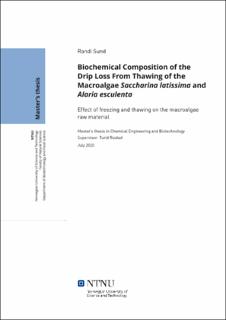| dc.description.abstract | Makroalger brukes som mat og som råmateriale for ekstraksjon av tilsetningsstoffer og funksjonelle forbindelser i blant annet matindustrien, kosmetikkindustrien og farmasøytisk industri. I løpet av de siste årene har den vitenskapelige og industrielle interessen for makroalger økt på grunn av deres potensiale innen bærekraftig produksjon av mat, energi og kjemikalier. Det har også vært en økt interesse blant forbrukere på grunn av det gunstige næringsinnholdet i makroalger, og innholdet av potensielt helsefremmende funksjonelle forbindelser. Passende konserveringsmetoder under frakt og lagring er nødvendige for å unngå forråtnelse av biomassen etter høsting. Frysing er en populær konserveringsmetode, men frysing og tining av makroalger fører til et betydelig drypptap. I denne oppgaven ble den kjemiske sammensetningen av drypptap fra tining, også kalt tinevann, av frosne prøver av makroalgeartene Saccharina latissima og Alaria esculenta analysert. Dette ble gjort for å se hvordan makroalgene ble påvirket av tining og frysing, og om tinevannprøvene kunne bli brukt som en supplerende inntektskilde i industrien. Konsentrasjonene av fuktighet, tørrstoff, aske, proteiner, totale aminosyrer og noen karbohydrater (mannitol, fucose, glukose, galaktose og mannose/xylose) ble bestemt for råstoffene, tinevannprøvene og restråstoffene etter tining og fjerning av tinevann. I tillegg ble konsentrasjonene av mineraler, fenoler og frie aminosyrer, og antioksidantaktiviteten bestemt for tinevannprøvene.
Tining av frossent Saccharina latissima og Alaria esculenta råstoff ga tinevann som utgjorde henholdsvis 49% og 55% av råstoffets våtvekt. Tinevannprøvene innehold over 90% fuktighet og litt tørrstoff. Over 70% av tørrstoffet var mineraler. Mineralinnholdet var dominert av natrium og kalium i begge tinevannprøvene. Jodinnholdet var også ganske høyt, spesielt for Saccharina latissima tinevannet. Det var også noe arsenikk, kvikksølv og kadmium i tinevannprøvene. Fenol- og proteinkonsentrasjonene var lave, begge disse, i tillegg til antioksidantaktiviteten, var høyere i Saccharina latissima tinevannet enn i Alaria esculenta tinevannet. Proteininnholdet virket som om det besto hovedsakelig av små peptider og frie aminosyrer. Av de målte karbohydratene var mannitol den det var mest av i tinevannprøvene. Noe fukose og glukose antydet også at det var noe fucoidan og laminaran i prøvene. Av aminosyrer var det mest alanin i tinevannprøvene, etterfulgt av mindre mengder glutaminsyre og asparaginsyre. Disse resultatene ga ingen innlysende bruksområder for tinevannprøvene. Ekstraksjon av jod og mannitol for videre industriell bruk virket som de mest realistiske bruksområdene. Dette antydet at næringsverdien av råstoffene ikke ble vesentlig påvirket av frysing og tining. Det er mulig at tining og frysing gjorde at restråstoffene hadde et sunnere mineralinnhold enn råstoffet på grunn av fjerning av jod og giftige tungmetaller. Tap av mannitol, alanin, glutaminsyre og asparaginsyre kan bety at smaken av restråstoffet er annerledes enn av råstoffet. | |
| dc.description.abstract | Macroalgae are used as food for human consumption and raw material for the extraction of additives and functional compounds in various industries such as the food, pharmaceutical and cosmetic industries. Recent years have shown increased scientific and industrial interest in macroalgae because of their potential within the sustainable production of food, energy, and chemicals. There has also been an increased consumer interest due to their beneficial nutritional profile, and their content of potentially health-promoting biologically active compounds. To avoid decay of the biomass after harvesting appropriate preservation methods are essential during transportation and storage. Freezing is a popular preservation method. However, freezing and thawing of macroalgae results in a substantial loss of liquid. In this study, the biochemical composition of drip loss from thawing of frozen samples of the macroalgae species Saccharina latissima and Alaria esculenta was studied. This was done to assess how the macroalgae raw material was affected by freezing and thawing, and if the drip losses could be used for value-added products in industry, either directly or for extraction of certain compounds. The concentrations of moisture, dry matter, ash, proteins, total amino acids, and some carbohydrates (mannitol, fucose, glucose, galactose, and mannose/xylose) were determined for the macroalgae raw material, drip loss from thawing and leftover raw material after removal of drip loss. Additionally, the concentrations of minerals, phenolic compounds, and free amino acids, as well as the antioxidant activity were determined for the drip losses.
Thawing of Saccharina latissima and Alaria esculenta raw materials resulted in drip losses of 49% and 55% of the raw material wet weight, respectively. The drip losses consisted of over 90% of moisture and a small amount of dry matter, of which about 70% was minerals. The mineral contents of both drip losses were dominated by sodium and potassium. The iodine concentration was also high, especially for the Saccharina latissima sample. Some arsenic, mercury and cadmium were also present in the drip losses. The concentrations of phenolic compounds and proteins were low, and these, as well as the antioxidant activity, were determined to be higher in the Saccharina latissima drip loss than in the Alaria esculenta drip loss. The protein content seemed to be mostly small peptides or free amino acids. Of the quantified carbohydrates, mannitol was the most abundant in the drip loss samples. Some fucose and glucose also indicated that the samples contained traces of fucoidan and laminaran. Alanine was the most abundant amino acid in the drip losses, followed by lower amounts of glutamic acid and aspartic acid. These results did not indicate any apparent direct uses for the drip losses. The most likely uses seemed to be for extraction of iodine or mannitol for further industrial uses. This indicated that the nutritional value of the Saccharina latissimia and Alaria esculenta raw material was not substantially affected by freezing and thawing. Additionally, freezing and thawing could result in a healthier mineral profile of the leftover raw material, due to removal of iodine and heavy metals. However, loss of mannitol, alanine, glutamic acid and aspartic acid could cause an altered flavour profile of the leftover raw material. | |
